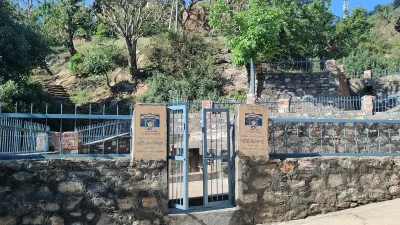California's Governor Jerry Brown unveils his administration's new plan in hopes of finally balancing the state's competing water interests. The cost? $14 billion over a decade.
California's broken water distribution system may finally have a fix, so says Governor Jerry Brown. As reported by The New York Times' Felicity Barringer and Jennifer Medina, "[t]he $14 billion blueprint envisions both the physical and psychological re-engineering of California's plumbing, including the construction of twin 35-mile-long pipelines, each about as wide as a three-lane highway, that would tap river water from a more northerly, less polluted location. The pipelines would deliver the water straight to the conveyances in the south, largely replacing a system that pumps water from the murkier southern part of the 500,000-acre delta, disturbing the fragile ecosystem."
Ever-increasing water withdrawals and levee building have led to what one environmentalist called a "biological meltdown." At the same time, "Decisions in recent years by the federal Fish and Wildlife Service and the courts to ensure there is enough water for fish have led to water delivery cutbacks in drought years." With the majority of stakeholders poorly served by the current situation, there is hope Gov. Brown's new plan will finally justly balance ecological, political, scientific, and industrial needs.
But lacking are details for the new plan. "Although Ann Nothoff, California advocacy director for the Natural Resources Defense Council, is troubled by the lack of detail in the proposal, she believes, "The status quo is unacceptable."
Although key details of the estimated $14 billion plan were missing (ignoring essential elements such as how much water would go through the pipes and when and scientific goals for recovery of endangered and threatened fish), it's clear who will end up paying the tab. "Those who consume water will have to cover the cost of construction; buying land and creating new habitat will fall to the government," write Barringer and Medina.
FULL STORY: California Envisions Fix to Water Distribution

Alabama: Trump Terminates Settlements for Black Communities Harmed By Raw Sewage
Trump deemed the landmark civil rights agreement “illegal DEI and environmental justice policy.”

Planetizen Federal Action Tracker
A weekly monitor of how Trump’s orders and actions are impacting planners and planning in America.

The 120 Year Old Tiny Home Villages That Sheltered San Francisco’s Earthquake Refugees
More than a century ago, San Francisco mobilized to house thousands of residents displaced by the 1906 earthquake. Could their strategy offer a model for the present?

In Both Crashes and Crime, Public Transportation is Far Safer than Driving
Contrary to popular assumptions, public transportation has far lower crash and crime rates than automobile travel. For safer communities, improve and encourage transit travel.

Report: Zoning Reforms Should Complement Nashville’s Ambitious Transit Plan
Without reform, restrictive zoning codes will limit the impact of the city’s planned transit expansion and could exclude some of the residents who depend on transit the most.

Judge Orders Release of Frozen IRA, IIJA Funding
The decision is a victory for environmental groups who charged that freezing funds for critical infrastructure and disaster response programs caused “real and irreparable harm” to communities.
Urban Design for Planners 1: Software Tools
This six-course series explores essential urban design concepts using open source software and equips planners with the tools they need to participate fully in the urban design process.
Planning for Universal Design
Learn the tools for implementing Universal Design in planning regulations.
Clanton & Associates, Inc.
Jessamine County Fiscal Court
Institute for Housing and Urban Development Studies (IHS)
City of Grandview
Harvard GSD Executive Education
Toledo-Lucas County Plan Commissions
Salt Lake City
NYU Wagner Graduate School of Public Service



























